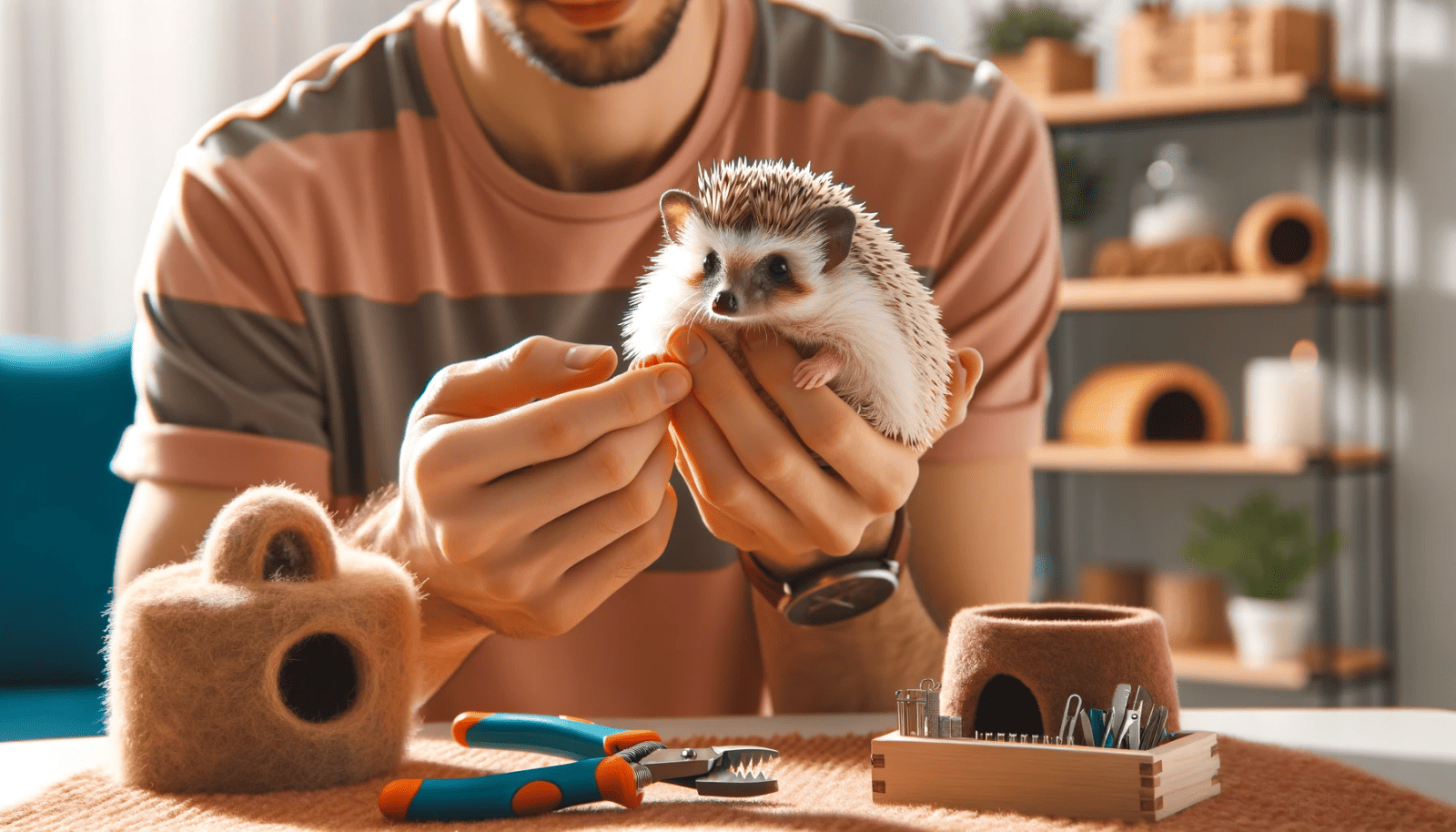Are you considering getting a hedgehog as a pet, but unsure about how to properly care for them? Look no further! In this article, we will debunk common myths and provide you with evidence-based facts about hedgehog care.
From creating the ideal habitat to understanding their behavior and health concerns, we’ve got you covered. With tips from experienced hedgehog owners, you’ll gain the knowledge and confidence needed to provide the best care for your furry friend.
Let’s dive in and separate fact from fiction!
Key Takeaways
- Provide a cozy hiding spot and a spacious enclosure for hedgehogs
- Feed hedgehogs a high protein diet and avoid feeding them citrus fruits or foods high in sugar
- Socialize hedgehogs early and consistently, gradually introducing new experiences and people
- Monitor hedgehog health and grooming regularly, including checking for mites or fungal infections, maintaining proper humidity, and providing opportunities for physical activity
The Ideal Hedgehog Habitat
You should consider providing a cozy hiding spot in the ideal hedgehog habitat. Creating an ideal hedgehog enclosure is essential for the overall well-being and happiness of your hedgehog. Hedgehogs are nocturnal creatures, so they need a safe and comfortable space to rest during the day. A hiding spot, such as a small hut or a specially designed hedgehog house, will give them the privacy they need.
When it comes to hedgehog habitat requirements, there are a few key factors to consider. First, the enclosure should be spacious enough for your hedgehog to move around comfortably. A minimum size of 4 square feet is recommended, but more space is always better. The enclosure should also have solid walls to prevent any potential escapes.
In addition to a hiding spot and ample space, providing the right temperature and lighting is crucial. Hedgehogs thrive in temperatures between 72-80°F (22-27°C), so it’s important to keep their habitat within this range. You can use heating pads or ceramic heat emitters to maintain a consistent temperature. As for lighting, hedgehogs need a natural light cycle, so it’s best to provide them with 12-14 hours of light and 10-12 hours of darkness.
Hedgehog Diet: What They Should and Shouldn’t Eat
Feeding your hedgehog the right diet is essential for their health and wellbeing. Hedgehogs have specific nutritional requirements that must be met to ensure they receive the necessary nutrients.
Here are some important points to consider when it comes to their diet:
Protein:
Hedgehogs require a high protein diet, consisting of around 30-35% protein. This can be provided through commercial hedgehog food or a combination of insects, lean meats, and cat food. Avoid feeding them fatty meats, as it can lead to obesity and other health issues.Fruits and Vegetables:
While hedgehogs can eat small amounts of fruits and vegetables, they shouldn’t make up a large portion of their diet. Stick to safe options like apples, carrots, and green beans. Avoid feeding them citrus fruits or any foods that are high in sugar.Feeding Schedule:
Hedgehogs are nocturnal animals, so it’s best to feed them in the evening or at night. Provide fresh food and water daily, removing any uneaten food to prevent spoilage.
Understanding Hedgehog Behavior
Hedgehogs are curious creatures, and they can exhibit a range of behaviors that may seem unusual or confusing to their owners. Understanding hedgehog behavior is essential for providing them with the best care possible.
One important aspect of hedgehog behavior is their communication. While they may not communicate in the same way as humans or other pets, hedgehogs do have their own unique ways of expressing themselves. They use a combination of vocalizations, body language, and scent marking to communicate their needs and emotions. For example, hedgehogs may make a variety of sounds, including hissing, clicking, and snuffling, to express their feelings. They may also puff up their quills, curl into a tight ball, or raise their spines as a defensive behavior when feeling threatened or scared.
Another important aspect of hedgehog behavior is socialization. Hedgehogs are generally solitary animals, but they still benefit from social interaction with their owners. To socialize your hedgehog effectively, it’s crucial to start early and be consistent. Spend time with your hedgehog daily, talking to them in a calm and soothing voice, and offering treats as positive reinforcement. Allow your hedgehog to explore their environment and handle them gently, ensuring they feel safe and secure. Gradually introduce new experiences and people to help them become more comfortable and less fearful.
Hedgehog Health: Common Issues and Concerns
One common concern for hedgehog owners is the health of their pet’s skin and quills. Taking proper care of your hedgehog’s health is essential to ensure their well-being. Here are some common issues and concerns related to hedgehog health, along with some helpful care tips:
Skin Irritations:
Hedgehogs are prone to dry skin, which can lead to irritations and flaking. Ensure a proper balance of humidity in their environment and consider using a humidifier if necessary.
Avoid using harsh soaps or shampoos when bathing your hedgehog, as this can further dry out their skin. Opt for mild, fragrance-free products specifically designed for small animals.
Regularly check for any signs of mites or fungal infections. If you notice any abnormalities, consult a veterinarian for appropriate treatment.
Quill Loss:
Quill loss is a natural process for hedgehogs as they shed old quills and grow new ones. However, excessive quill loss or bald patches may indicate an underlying health issue. Consult a veterinarian if you notice this problem.
Obesity:
Hedgehogs have a tendency to become overweight if not provided with a balanced diet and enough exercise. Ensure they have a proper diet that includes high-quality hedgehog food, supplemented with occasional treats like insects or fruits.
Provide your hedgehog with plenty of opportunities for physical activity, such as a large enclosure with tunnels, wheels, and toys.
How to Handle and Bond With Your Hedgehog
When handling and bonding with your hedgehog, remember to approach them slowly and gently, allowing them to become comfortable with your presence. Hedgehogs are naturally shy creatures, so it’s important to give them time and space to adjust to their new environment and to you as their caregiver.
To bond with a shy hedgehog, start by sitting near their enclosure and talking softly to them. This will help them get used to your voice and presence. Once they seem comfortable, you can try offering them treats from your hand, using gloves if necessary to protect yourself from their spines. Gradually increase the amount of time you spend handling them, always being mindful of their comfort level. Patience and consistency are key when bonding with a shy hedgehog.
When it comes to introducing your hedgehog to other pets, such as dogs or cats, it’s important to proceed with caution. Hedgehogs are prey animals, and their natural instinct is to curl up into a ball when they feel threatened. This can trigger predatory instincts in other animals. Start by allowing your pets to sniff each other through a barrier, such as a baby gate or a wire cage, to gauge their reactions. If everyone seems calm and curious, you can try supervised, controlled interactions. Always prioritize the safety and well-being of your hedgehog and monitor the situation closely.
Hedgehog Grooming: What You Need to Know
To keep your hedgehog healthy and comfortable, you should regularly groom them and be aware of their specific grooming needs. Hedgehogs are generally clean animals, but they still require some grooming to maintain their overall well-being. Here are some hedgehog grooming techniques and common grooming mistakes to avoid:
Bathing: Hedgehogs should only be bathed when necessary, as excessive bathing can cause dry skin. Use a shallow container with warm water and a hedgehog-friendly shampoo. Gently lather and rinse, making sure to keep their face dry.
Nail Trimming: Hedgehog nails can become sharp and long if not regularly trimmed. Use specially designed small animal nail clippers and be cautious not to trim too close to the quick. If you’re unsure, consult a veterinarian.
Brushing: Regular brushing helps remove loose quills and promotes healthy skin and fur. Use a soft-bristled brush or a toothbrush to gently brush their quills in the direction they naturally lay.
Common grooming mistakes to avoid include using harsh or scented shampoos that can irritate their sensitive skin, neglecting nail trimming, and over-bathing.
It’s important to remember that each hedgehog is unique, so observe your pet’s grooming needs and adjust accordingly. By following proper hedgehog grooming techniques, you can ensure your furry friend stays clean and comfortable.
Creating a Safe and Enriching Environment for Your Hedgehog
Ensure your hedgehog’s safety and happiness by creating an environment that’s both secure and stimulating. Hedgehog enrichment and safety measures are essential components of hedgehog care.
To provide a safe environment, start by selecting a suitable enclosure. A large, escape-proof cage with solid sides and a secure lid is necessary to prevent your hedgehog from getting out or other pets from getting in. Avoid wire-bottomed cages, as they can cause foot injuries. Additionally, hedgehogs are natural burrowers, so provide them with plenty of bedding material, such as paper-based bedding or fleece liners, to create a cozy and comfortable space.
In terms of enrichment, hedgehogs are intelligent and curious creatures that require mental stimulation. Provide them with a variety of toys, such as tunnels, hideaways, and puzzle feeders, to keep them entertained. Rotate the toys regularly to prevent boredom. Hedgehogs also enjoy exploring and foraging, so scatter some treats or hide their food in different areas of the enclosure. This will encourage natural behaviors and keep them active.
While creating an enriching environment, it’s crucial to ensure safety. Remove any toxic plants or objects that could be harmful if ingested. Hedgehogs have a tendency to chew on things, so be cautious of any potential hazards. Keep electrical cords out of reach or cover them with cord protectors. Additionally, maintain a suitable temperature between 72-80°F (22-27°C) to keep your hedgehog comfortable and prevent hibernation attempts.
Hedgehog Exercise: Keeping Them Active and Happy
To keep your hedgehog active and happy, provide them with regular opportunities for exercise and play. Hedgehogs are naturally active animals, and exercise is essential for their physical and mental well-being.
Here are some options for hedgehog exercise:
Indoor vs. Outdoor Options:
Indoor exercise: Set up a safe and secure space where your hedgehog can explore and roam freely. Remove any potential hazards and ensure the area is escape-proof.
Outdoor exercise: If you choose to take your hedgehog outdoors, always supervise them closely. Use a secure and enclosed area, like a playpen, to prevent them from escaping or encountering dangerous wildlife.
Hedgehog Toys:
Exercise wheels: Hedgehogs love running on wheels, and it provides them with a great source of exercise. Choose a solid-surface wheel with a diameter of at least 12 inches to prevent injuries.
Puzzle toys: Introduce puzzle toys that require your hedgehog to work for their treats or food. This not only provides mental stimulation but also encourages physical activity.
Tunnel systems: Hedgehogs enjoy exploring tunnels and burrowing. Provide them with tunnels and hideouts to keep them entertained and active.
Enrichment:
Obstacle courses: Create a mini-obstacle course using objects like tunnels, ramps, and platforms. This will challenge your hedgehog’s agility and encourage them to move and explore.
Rotating toys: Regularly rotate your hedgehog’s toys to keep them engaged and prevent boredom.
Sensory stimulation: Hedgehogs have a keen sense of smell. Introduce scented toys or hide treats to encourage activity and mental stimulation.
Hedgehog Lifespan and Aging: What to Expect
Take note of the hedgehog’s lifespan and what you can expect as they age. Understanding the aging process is crucial in providing proper care for your hedgehog. Hedgehogs have an average lifespan of four to six years, although some can live up to eight years with excellent care. As they age, hedgehogs may experience various changes in their physical and behavioral health.
One important aspect of hedgehog care is providing a comfortable environment for aging hedgehogs. As they get older, hedgehogs may become less active and require a more relaxed living space. Ensure that their enclosure is spacious enough to accommodate their reduced mobility and provide soft bedding for comfort. Regularly cleaning their habitat becomes even more critical to prevent any health issues.
Additionally, pay attention to their diet as hedgehogs age. Their nutritional needs may change, and it’s essential to provide a balanced diet that supports their aging bodies. Consult with a veterinarian to determine the best diet for your aging hedgehog.
As hedgehogs age, they may also experience age-related health issues such as dental problems, arthritis, and weight gain. Regular veterinary check-ups and monitoring their overall health are essential in detecting and managing these issues.
Hedgehog Breeding: The Facts Behind the Fiction
When it comes to hedgehog breeding, it’s important to separate the facts from the fiction. Hedgehog breeding should always be approached with ethical considerations and responsible breeding practices. Here are some key points to keep in mind:
Breeding Age: Female hedgehogs can be bred as early as four months of age, but it’s generally recommended to wait until they’re six months old to ensure they’re physically mature and ready for pregnancy.
Breeding Seasons: Hedgehogs are seasonal breeders, with their breeding season typically occurring from late winter to early spring. It’s important to be aware of these natural cycles and plan breeding accordingly.
Health Screening: Before breeding a hedgehog, it’s crucial to ensure that both the male and female are in good health. This includes regular veterinary check-ups, testing for genetic diseases, and ensuring they’re free from any parasites or infections.
By following these ethical considerations and responsible breeding practices, you can help maintain the health and well-being of hedgehogs.
It’s important to remember that breeding should be done with the best interests of the hedgehogs in mind, and not solely for financial gain. Responsible breeding can contribute to the preservation and improvement of hedgehog populations, ensuring their long-term welfare.
Hedgehog Myths Busted: Separating Fact From Fiction
Don’t believe the misconceptions – let’s debunk some hedgehog myths and separate fact from fiction. When it comes to hedgehog care, there are many myths circulating that can lead to improper care for these adorable creatures. It’s important to have accurate information to ensure the well-being of your hedgehog.
One common myth is that hedgehogs are low-maintenance pets. While they may not require as much attention as some other pets, hedgehogs still need daily care and interaction. They need a clean and spacious cage, a proper diet, and regular exercise. Additionally, hedgehogs are nocturnal animals, so they may be more active at night, requiring some adjustments to your schedule.
Another myth is that hedgehogs are easy to handle. While they can be friendly and sociable, some hedgehogs may be timid or shy. It’s important to approach them gently and give them time to get used to you. Handling a hedgehog requires patience and understanding of their unique needs.
One common misconception is that hedgehogs are solitary animals. While they can be solitary by nature, they still need mental stimulation and social interaction. Providing them with toys, hiding spots, and regular playtime can help keep them happy and entertained.
It is also crucial to address the myth that hedgehogs can eat any food. Hedgehogs have specific dietary requirements and need a balanced diet that includes high-quality commercial hedgehog food, supplemented with occasional fruits, vegetables, and insects. It’s important to avoid feeding them foods that are toxic or harmful to their health.
Hedgehog Care Tips From Experienced Owners
Get ready to level up your hedgehog care skills with some valuable tips from experienced owners. Taking care of a hedgehog involves more than just providing food and shelter. Here are some tried and true tips that will help you provide the best care for your prickly friend:
Hedgehog Odor Control:
Regular cleaning: Clean your hedgehog’s cage at least once a week to minimize odors. Use a mild detergent and warm water to clean the cage and remove any urine or feces.
Proper bedding: Choose bedding that’s absorbent and helps control odors, such as paper-based bedding or aspen shavings. Avoid using cedar or pine bedding, as these can be harmful to hedgehogs.
Bathing: Hedgehogs are naturally clean animals and don’t require frequent baths. However, if your hedgehog starts to smell, you can give them a shallow warm water bath with a hedgehog-safe shampoo. Make sure to dry them thoroughly to prevent chill.
Introducing a New Hedgehog to Your Current One:
Quarantine period: Before introducing a new hedgehog to your current one, keep them separate for a few weeks to ensure they’re healthy and free from any potential diseases.
Slow introduction: Start by placing the new hedgehog’s cage next to the current hedgehog’s cage so they can get used to each other’s scent. Gradually allow supervised interactions in a neutral space, such as a playpen, and monitor their behavior closely.
Separate living spaces: Provide separate cages for each hedgehog to retreat to if they need their own space. This will help prevent territorial disputes and ensure their safety.
Frequently Asked Questions
Can Hedgehogs Be Kept as Outdoor Pets?
Yes, hedgehogs can be kept as outdoor pets. To ensure their safety, it’s important to have outdoor hedgehog enclosures and hedgehog proof your yard. This will provide them with a suitable environment to thrive in.
How Often Should I Bathe My Hedgehog?
You should bathe your hedgehog once every 4-6 weeks. Use a shallow, warm water bath and mild, fragrance-free soap. Gently scrub their quills and belly, being careful not to get water in their ears or eyes.
Are Hedgehogs Prone to Any Specific Diseases?
Hedgehogs, like any other animals, are prone to specific diseases. It is important to be aware of hedgehog health concerns and take necessary precautions to ensure their well-being.
What Is the Average Lifespan of a Hedgehog?
The average lifespan of a hedgehog is about 4-7 years. However, with proper hedgehog breeding and a balanced hedgehog diet, it is possible for them to live up to 10 years or more.
Is It Necessary to Trim a Hedgehog’s Nails?
Yes, it’s necessary to trim a hedgehog’s nails. Regular trimming helps prevent overgrowth and discomfort. Do’s: use proper nail clippers and trim just the tips. Don’ts: cut too deep or use human clippers.
Conclusion
In conclusion, caring for a hedgehog requires a proper understanding of their habitat, diet, behavior, health, handling, lifespan, and breeding. By separating fact from fiction and debunking common myths, we can ensure that hedgehog owners provide the best possible care for their prickly companions.
Remember, knowledge is the key to a happy and healthy hedgehog. So, let’s embrace the spiky charm of these adorable creatures and give them the care they deserve.
As the saying goes, ‘A well-informed hedgehog owner is a hedgehog’s best friend.’















Leave a Reply
View Comments